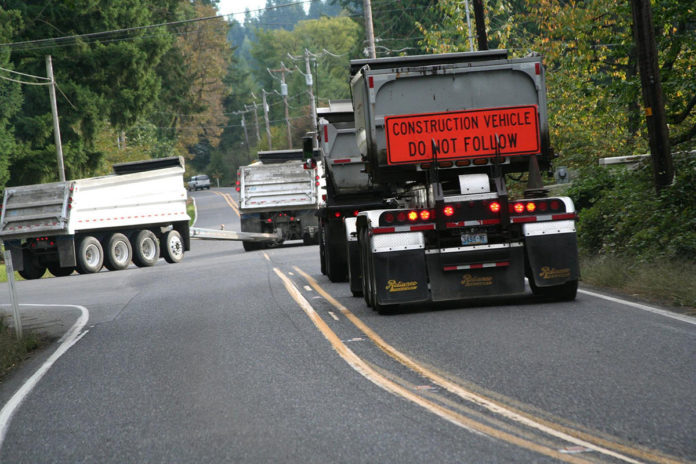After looking into several different studies on the state of construction rock and aggregate in Clark County, members of the Southwest Washington Contractors Association (SWCA) and other construction/building groups in the area say that the county is facing several challenges with its permitted construction aggregate reserves.
“It’s a classic case of supply and demand,” said SWCA members, in a joint statement. “Right now we have high demand for rock as the county continues to undergo impressive development in many areas (not just in terms of residential units but also the commercial and industrial units needed for business, and of course road maintenance). Unfortunately, the reality is when the demand for rock can’t be met by the current supply, it has to come from somewhere. That means paying more for hauling or barging the rock from other areas, such as hauling materials from pits two to three hours away, or barging rock from our Canadian friends in British Columbia.”
“To put this into perspective, rock could cost double what it already costs now and that’s already beginning to happen,” the statement continued. “The rising cost of rock is already becoming a reality for our local contractors. It’s not uncommon to find a contractor who bid rock at $350 per load six months ago and is now starting that project and having to pay $500-plus per load.”
According to the Washington Department of Natural Resources (DNR), aggregate, which is the most valuable mineral commodity in the state of Washington, is necessary to manufacture concrete, asphalt and other products. Aggregate products are the building blocks for the community’s homes, businesses, roads and bridges. Once purchased, aggregate is transported to different sites via truck, rail or barges, with 93% of all aggregate being transported by truck nationally.
In 2010, Washington had 955 permitted mines, according to DNR. Currently, the Growth Management Act (GMA) that local jurisdictions identify and classify aggregate and mineral resource lands from which the extraction or minerals occurs are can be anticipated. Washington DNR prepared an aggregate resource map – for use by local governments and others – to identify areas where sand and gravel and bedrock might be extracted and used as concrete aggregate or asphalt-treated base. However, studies/maps define aggregate resources as naturally occurring gravel or bedrock aggregate estimated or inferred to exist on the basis of a favorable geologic setting, little or no sampling and only general knowledge of past aggregate production.
In addition, the DNR’s map does not establish reserves, and only focuses on rock resources used for concrete and asphalt aggregate purposes and doesn’t consider building stone or industrial mineral uses.
“Clark County is behind in assuring a sufficient two-decade local supply of aggregate rock, which is a condition of the Growth Management Act,” said Ron Arp, president of Identity Clark County. “We’ll need to access everything that is accessible today and pursue additional capacity soon to meet our forecast needs for construction and infrastructure.”
“Mining isn’t popular or easy, but our local mining and transportation leaders work very hard to operate responsibly and with sensitivity to nature and neighbors,” Arp continued. “The alternative is to transport aggregate from several hours away, which boosts construction and consumer costs, reduces local economic activity and tax revenue, and shortens the life cycle of our region’s roads.”
According to a Clark County Aggregate Reserves Study, there is a “rapidly decreasing amount of permitted reserves combined with high demand for aggregate in the rapidly growing county.” The study states that Clark County only has seven years of reserves, per capita demand of aggregate. Of the 25 “active” mines in the county, 12 are active with permitted reserves; only nine are producing construction aggregate material for houses, bridges, roads, hospitals, etc.; and 99% of permitted reserves are sourced from only six mines.
The study concludes that there is a need for expanded permitted resources in Clark County to avoid supply issues and pricing inflation.
Andrea Smith, marketing & government relations director for the SWCA, said SWCA members believe that permitting needs to be relaxed in order to up supply levels of aggregate. Starting a mine is a seven to 10 year process, and the cost of permitting alone is $10,000-$15,000. By the time geological studies have been done, land has been bought, property taxes, etc., the price tag can be up in the millions of dollars to just get a pit started.
Smith said the SWCA, Identity Clark County (ICC) and the Building Industry Association of Clark County (BIA) are looking to present this information to the Clark County Council in the next month or so, and inform them about the supply of aggregate in the county and what it means for the cost of development.
“Rock and aggregate resources build our communities, they are the foundation,” Smith said. “If quarry operations are limited, we will all have to pay more in taxes for road repairs, pay more for newly constructed homes or reduce school bond buying power in the future. The county needs rock and if the limitations on the operations of quarries continues, we will soon be dry. Our members always reference what’s happened in the Bay Area: price inflation of aggregate materials because of urban development with no strategic natural resources planning. Of course there are many factors as to why California is so expensive to live and we can’t speculate on the basis of one variable, but I can’t help but think of the impact aggregate resource inflation may have had on their cost of living.”



